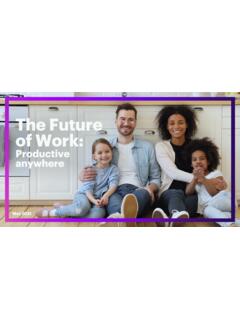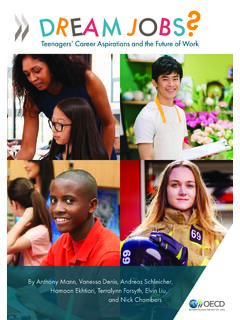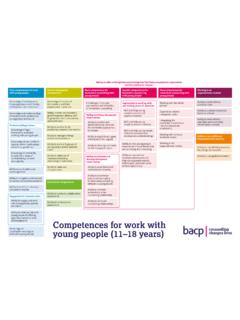Transcription of The Future of Work: a trends forecast for 2022
1 The Future of work : a trends forecast for 2022. H Y B R I D WO RKING: A N E R A - DE F I N I N G REVO LU TIO N. The world of work is in a constant state how millions of people work will be with us for good. of flux. But change has usually been And I say that if the massive acceleration we're seeing in the uptake of hybrid working is the pandemic's slow over the centuries, taking years or ultimate legacy, then at least part of its impact can be decades rather than months or weeks. said to be positive. First, millions no longer need to make a daily commute, Every now and again, however, something really slashing carbon emissions and helping us collectively dramatic happens that changes things for ever. The drive our way to net zero. Then there is that parallel Industrial Revolution. The railway. The motor car. increase in the numbers of people working at or close The desktop computer.
2 The internet. to their homes in flexible workspaces, seeing more of their families and friends and doing more to support Today, we are witnessing another of these seminal local economies and participate in their communities. moments with the hybrid working phenomenon where people can work either at home or in a local flexible Companies are also benefiting from significant falls in workspace, with an occasional visit to the head office. their real estate costs, along with tangible productivity gains and an increased ability to attract the best talent We mustn't underestimate the significance of what we no matter where they are located. Hybrid working is no are witnessing. In years to come, the hybrid revolution' longer a nice to have: more than 70% of candidates are will be recognised as every bit as important as anything now insisting that companies have a flexible work policy.
3 That has gone before. Firms have also come to realise that they no longer The original catalyst for this shift is the digital revolution, need a sea of desks in a single, expensive city-centre which started in the 1970s with the launch of the first location. Instead they are reconfiguring their office personal computers. Today, digital technology puts into footprint, bringing offices closer to their people and every white-collar worker's hands all the tools they adopting the hub-and-spoke model. need to do their job. But it has only been in the last four or five years with advancements in technology that the work in the Future will be happening in the heart of shift towards hybrid working has gathered pace. local communities everywhere cities and suburbs, towns and villages and IWG's focus is on providing The office today is no longer a defined physical place.
4 Local workplaces that people can access close to Rather, it is a digital construct. Often, data saved in home, no matter where they live. the Cloud isn't even in the same country as the staff accessing it. This is just the beginning of something truly era-defining that will have a tremendously positive So why should workers go to the effort and expense impact on Future generations, freeing so many up of dragging themselves into work to spend the day to lead less stressed and more enriched lives. working on a device they have brought with them, and will take back home at the end of the day? Offices are here to stay, but it is a new breed, the hybrid office, that will prevail. While the Covid-19 pandemic is set to only be a temporary phenomenon, it's clear that its effects on Mark Dixon, Founder and CEO, IWG plc work in the Future will be happening in the heart of local communities everywhere, so our focus at IWG is on providing local workplaces that people can access close to home, no matter where they live.
5 The ten trends shaping work in 2022. 1. Human relations At last, there is recognition that people are not commodities. Rather than HR standing for human resources, in the hybrid world it can be rebranded as human relations'. This is because companies are realising that happier employees are more productive, and they are therefore investing in mental health, employee wellbeing and improved lines of communication. At its best, hybrid working embodies respect and personalisation, meaning that no matter what an employee's needs are, they will always have a place to work that best suits them and the flexibility to deliver what is required of them outside the confines of a traditional 9-5. working week. With this in mind, the hybrid model naturally aligns with better mental health because people are less frequently forced to compromise their own needs for those of the company's.
6 We have already seen employers such as Nike, Bumble, KPMG, The New York Times and LinkedIn giving staff impromptu pop-up' paid leave to reboot or spend some time on a passion project in a bid to avoid mass burnout. This is because they are realising that stress is a major problem not just for individual workers but for businesses as well (and the pandemic has been highly stressful for almost everyone). According to the American Institute of Stress, companies in the US lose US$300bn per year as a result of absenteeism, so things really need to change. In years to come, many firms will be proud to say they are part of the Caring Economy'. 2. Hyper flexibility Not so long ago, being able to work from home was something that had to be negotiated with employers, and more often than not they were hesitant for people to do so in case it set a precedent for others in the same company.
7 Having an inflexible blanket rule that compelled everyone to be at their desk was the default way of operating. Pre-pandemic, some forward-looking companies were beginning to embrace flexible working but, in 2022 and beyond, hyper flexibility will be an expectation. And if companies don't allow it, people will look elsewhere for a job. Last year, an IWG survey revealed that almost half of all office workers would quit if asked to go back to the office five days a week, while nearly three quarters said they would prefer the option of hybrid working to a 10% pay rise, if offered the choice. According to the US Labor Department, a record high of million people (3% of workers) left their jobs in the US in September 2021, reflecting a global upheaval in the recruitment market. Following the Great Resignation', as the phenomenon has been called, there will be a swing the other way as companies compete to attract talent with ever-more compelling policies and perks, as employees seek the hours, days and locations that suit them best.
8 Whereas before the pandemic employers were the ones setting the agenda, during the Great Rehiring', it will be employees who determine what work looks like and how it should be balanced with their personal lives. And canny companies are realising how to attract talent in Last year, an IWG survey this new world of work . According to flexible working consultancy revealed that almost half of Timewise, the proportion of job adverts offering flexible working has almost doubled to 26% since the beginning of the pandemic. all office workers would quit if asked to go back to the With the new focus on output and performance rather than time spent office five days a week at a desk, there could even be more widespread adoption of initiatives such as a four-day work week, which has already been successfully trialled in countries such as Iceland and New Zealand.
9 3. Workforce dispersion With employees able to work from anywhere, recruiting from a national or even global pool of candidates (rather than purely local). will become the norm for companies, giving them the chance to find the very best candidates for a job vacancy. At the same time, it will open up even greater possibilities for employees who, before the hybrid working boom, would have needed to commute long distances or move to the city to perform their role in a central office. Of course, there will still be demand for company HQs as places for people to come together and collaborate, but the hybrid model also allows for people to work remotely both from home and local flexible workspaces. For example, a company in California could hire someone living in London to do a job that previously would have needed them to relocate to San Francisco. In the hybrid world, they can simply check in via Zoom from a coworking site in Mayfair and visit the transatlantic head office two or three times a year.
10 Workforce dispersion is happening within borders, too, for two main reasons. Thanks to the ability to work from anywhere, employees are moving out of cities to more rural and coastal areas where they can have a better work -life balance, while companies can recruit talent from more remote locations than would previously have been possible. In this way, having a network of suburban flexspace hubs that act as convenient satellites' around a city centre HQ can allow companies to adopt the hub-and-spoke' model, whereby employees have access to workspace closer to where they live, driving down the need to be a super commuter'. Workforce dispersion is also a great way of building diversity into organisations, as well as providing socio-economic uplift to people and places that might otherwise have remained on the margins. According to Tamas Varkonyi, People and Operations Manager at equity management platform Ledgy: Current and Future employees can come from and live in completely different situations every day.







